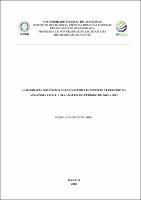| ???jsp.display-item.social.title??? |


|
Please use this identifier to cite or link to this item:
https://tede.ufam.edu.br/handle/tede/6467| ???metadata.dc.type???: | Dissertação |
| Title: | A geografia dos óbitos causados por transporte terrestre na Amazônia Legal: uma análise do período de 2009 a 2013 |
| ???metadata.dc.creator???: | Colares, Isabela Soares  |
| ???metadata.dc.contributor.advisor1???: | Souza, Geraldo Alves de |
| ???metadata.dc.contributor.referee1???: | Nassi, Carlos David |
| ???metadata.dc.contributor.referee2???: | Silva Neto, João Cândido André da |
| ???metadata.dc.description.resumo???: | O aumento da taxa de motorização se caracteriza como uma das principais causas de crescimento dos óbitos por Acidentes de Transporte Terrestre – ATT no Brasil. Reconhece-se este como um fator importante, porém, acredita-se ser necessário avaliar as realidades que caracterizam cada contexto regional e local. Ao contrário do restante do país, a Amazônia Legal apresenta uma configuração geográfica com padrões de cidades cuja gênese ocorreu às margens dos rios navegáveis, e algumas destas ainda permanecem até os dias atuais acessadas apenas por transporte hidroviário. Por outro lado, mais recentemente, uma rede de rodovias foi implantada na região, dando origem a novos núcleos urbanos às suas margens. A presente pesquisa valeu-se dessas diferenças de tipo de acesso às sedes dos municípios para compreender a distribuição das ocorrências de óbitos por ATT na região. Levando em consideração estas singularidades, esta dissertação teve como objetivo geral analisar a relação entre os diferentes tipos de acesso às cidades, a distribuição da população, da frota de veículos e o número acumulado de ocorrências por ATT no período de 2009-2013. Os dados utilizados na pesquisa foram do Sistema de Informação de Mortalidade do Sistema Único de Saúde – SIM/SUS, correspondente ao somatório do período, a população de 2010, disponibilizada pelo Instituto Brasileiro de Geografia e Estatística – IBGE, a frota de veículos de 2013, do Departamento Nacional de Infraestrutura – DNIT. Os dados alfanuméricos foram preparados em planilhas eletrônicas e importados para um Sistema de Informação Geográfica – SIG para geração de mapas temáticos sobre a região. Os resultados apontam que os municípios com ligação por rodovias apresentam maior relação de veículos por habitante e, consequentemente, maior quantidade de óbitos por ATT que aqueles situados às margens de rios. Encontrou-se uma forte correlação entre as variáveis analisadas, sendo os municípios populosos e com maior frota de veículos os que apresentam os maiores índices de vítimas por ATT na Amazônia Legal. |
| Abstract: | The increase in the rate of motorization is one of the main causes of the increase in deaths due to Road Traffic Accidents - RTA in Brazil. This is recognized as an important factor, but it is believed that it is necessary to evaluate the realities that characterize each regional and local context. Unlike the rest of the country, the Legal Amazon presents a geographic configuration with patterns of cities whose genesis occurred on the margins of navigable rivers, and some of these still remain until the present day accessed only by waterway transportation. On the other hand, more recently, a network of highways was implanted in the region, giving rise to new urban centers to its banks. The present research was based on these differences in the type of access to the municipalities' headquarters in order to understand the distribution of occurrences of deaths by RTA in the region. Taking into account these singularities, this dissertation had as a general objective to analyze the relationship between the different types of access to cities, the distribution of the population, the fleet of vehicles and the cumulative number of occurrences by RTA in the period 2009-2013. The data used in the research were from the Sistema de Informação de Mortalidade (Mortality Information System) of the Sistema Unificado de Saúde (Unified Health System) - SIM / SUS, corresponding to the sum of the period, the population of 2010, made available by the Instituto Brasileiro de Geografia e Estatística (Brazilian Institute of Geography and Statistics) - IBGE, the vehicle fleet of 2013, from the Departamento Nacional de Infraestrutura (National Department of Infrastructure) - DNIT. The alphanumeric data were prepared in electronic spreadsheets and imported into a Geographic Information System (GIS) to generate thematic maps about the region. The results indicate that the municipalities with road link have a higher ratio of vehicles per inhabitant and, consequently, a greater number of deaths by RTA than those located on the river banks. A strong correlation was found between the variables analyzed, with the populous municipalities and with the largest vehicle fleet having the highest rates of RTA victims in the Legal Amazon. |
| Keywords: | Amazônia Legal Frota de veículos Transporte terrestre - Acidentes |
| ???metadata.dc.subject.cnpq???: | CIÊNCIAS HUMANAS: GEOGRAFIA |
| Language: | por |
| ???metadata.dc.publisher.country???: | Brasil |
| Publisher: | Universidade Federal do Amazonas |
| ???metadata.dc.publisher.initials???: | UFAM |
| ???metadata.dc.publisher.department???: | Instituto de Filosofia, Ciências Humanas e Sociais |
| ???metadata.dc.publisher.program???: | Programa de Pós-graduação em Geografia |
| Citation: | COLARES, Isabela Soares. A geografia dos óbitos causados por transporte terrestre na Amazônia Legal: uma análise do período de 2009 a 2013. 2018. 143 f. Dissertação (Mestrado em Geografia) - Universidade Federal do Amazonas, Manaus, 2018. |
| ???metadata.dc.rights???: | Acesso Aberto |
| ???metadata.dc.rights.uri???: | http://creativecommons.org/licenses/by-nc-nd/4.0/ |
| URI: | https://tede.ufam.edu.br/handle/tede/6467 |
| Issue Date: | 4-Apr-2018 |
| Appears in Collections: | Mestrado em Geografia |
Files in This Item:
| File | Description | Size | Format | |
|---|---|---|---|---|
| Dissertação_IsabelaColares_PPGEOG.pdf | 7.74 MB | Adobe PDF |  Download/Open Preview |
This item is licensed under a Creative Commons License





